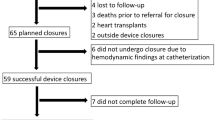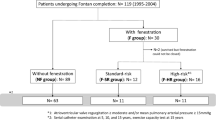Abstract
Fenestration closure is considered to remove the persistent right-to-left shunt after the Fontan operation. However, the criteria for effective transcatheter closure of fenestration to avoid both acute and chronic Fontan failure have not been clarified. The objective of this study was to describe the hemodynamic data with test occlusion of the Fontan fenestration for patients who underwent a closure and those who did not, along with subsequent development of Fontan-associated diseases (FAD) at follow-up. This was a retrospective study conducted to assess the outcome of Fontan fenestration closure at Children’s Hospital of Michigan over 27 years (1993–2019). The inclusion criteria were patients undergoing cardiac catheterization indicated for Fontan fenestration closure. Data were compared between the two groups: closure and non-closure patients. Baseline characteristics and hemodynamic variables with the fenestration occlusion test were analyzed. The primary outcome was the development of composite events of death/transplant, deteriorated New York Heart Association class symptoms, or FAD. Among the 38 patients who were brought to the catheterization laboratory, 33 received fenestration closure and 5 did not. On a median follow-up of 3.4 years (range, 1 month–12.6 years), the incidence of primary adverse outcomes was 13% (5/38). The incidence of primary outcome was significantly higher in the non-closure group (60% vs. 6%, p < 0.01). The non-closure group had a higher incidence of moderate or severe atrioventricular valve regurgitation, New York Heart Association class III symptoms, use of angiotensin-converting enzyme inhibitor/angiotensin receptor blocker, furosemide use, and sildenafil use. The multivariable logistic regression model showed that the hemodynamic variables associated with the non-closure group were mean left atrial pressure (odds ratio 1.74, p < 0.05) and change of mean Fontan pressure at the balloon occlusion (odds ratio 2.2, p < 0.05). The judgment of fenestration closure appeared appropriate in our cohort. Fontan fenestration closure may not be advisable in cases with a high baseline left atrial pressure or a significant increase in Fontan pressure on balloon occlusion testing.


Similar content being viewed by others
References
Lemler MS, Scott WA, Leonard SR, Stromberg D, Ramaciotti C (2002) Fenestration improves clinical outcome of the fontan procedure: a prospective, randomized study. Circulation 105:207–212
Meadows J, Lang P, Marx G, Rhodes J (2008) Fontan fenestration closure has no acute effect on exercise capacity but improves ventilatory response to exercise. J Am Coll Cardiol 52:108–113
Momenah TS, Eltayb H, Oakley RE, Qethamy HA, Faraidi YA (2008) Effects of transcatheter closure of Fontan fenestration on exercise tolerance. Pediatr Cardiol 29:585–588
Kotani Y, Chetan D, Saedi A, Saedi A, Zhu J, Grosse-Wortmann L, Coles JG, Caldarone CA, Arsdell GSV, Honjo O (2014) Persistent fenestration may be a marker for physiologic intolerance after Fontan completion. J Thorac Cardiovasc Surg 148:2532–2538
Garekar S, Walters HL, Delius RE, Thomas RL, Ross RD (2006) Intermediate outcomes of fenestrated Fontan procedures. J Thorac Cardiovasc Surg 131:247–249
John AS, Johnson JA, Khan M, Driscoll DJ, Warnes CA, Cetta F (2014) Clinical outcomes and improved survival in patients with protein-losing enteropathy after the Fontan operation. J Am Coll Cardiol 64:54–62
Hijazi ZM, Fahey JT, Kleinman CS, Kopf GS, Hellenbrand WE (1992) Hemodynamic evaluation before and after closure of fenestrated Fontan. An acute study of changes in oxygen delivery. Circulation 86:196–202
Feltes TF, Bacha E, Beekman RH III, Cheatham JP, Feinstein JA, Gomes AS, Hijazi ZM, Ing FF, Moor M, Morrow WR, Mullins CE, Taubert KA, Zahn EM, American Heart Association Congenital Cardiac Defects Committee of the Council on Cardiovascular Disease in the YoungCouncil on Clinical Cardiology, Council on Cardiovascular Radiology and Intervention, American Heart Association (2011) Indications for cardiac catheterization and intervention in pediatric cardiac disease: a scientific statement from the American Heart Association. Circulation 123:2607–2652
Bridges ND, Lock JE, Mayer JE Jr, Burnett J, Castaneda AR (1995) Cardiac catheterization and test occlusion of the interatrial communication after the fenestrated Fontan operation. J Am Coll Cardiol 25:1712–1717
Goff DA, Blume ED, Gauvreau K, Mayer JE, Lock JE, Jenkins KJ (2000) Clinical outcome of fenestrated Fontan patients after closure: the first 10 years. Circulation 102:2094–2099
Moore JW, Murdison KA, Baffa GM, Kashow K, Murphy JD (2000) Transcatheter closure of fenestrations and excluded hepatic veins after fontan: versatility of the Amplatzer device. Am Heart J 140:534–540
Pihkala J, Yazaki S, Mehta R, Lee KJ, Chaturvedi R, McCrindle BW, Arsdell GV, Benson LN (2007) Feasibility and clinical impact of transcatheter closure of interatrial communications after a fenestrated Fontan procedure: medium-term outcomes. Catheter Cardiovasc Interv 69:1007–1014
Masura J, Bordacova L, Tittel P, Berden P, Podnar T (2008) Percutaneous management of cyanosis in Fontan patients using Amplatzer occluders. Catheter Cardiovasc Interv 71:843–849
Al-Hay AA, Abushaban L, Al-Qbandi MA, Alanbaei M (2011) Occlusion of Fontan fenestrations using Amplatzer septal occluder. Int J Cardiovasc Imaging 27:483–490
Malekzadeh-Milani S, Ladouceur M, Bajolle F, Bonnet D, Boudjemline Y (2015) Closure of Fontan fenestration with the use of covered stents: short- and mid-term results in a cohort of 50 patients. Cardiol Young 25:868–873
Pihkala JI, Järvelä M, Boldt T, Jokinen E, Liikanen I, Mattila I, Eerola A (2016) Fate of fenestration in children treated with fontan operation. Catheter Cardiovasc Interv 87:E233–E239
Góreczny S, Dryżek P, Morgan GJ, Kula AM, Moll JJ, Moll JA, Qureshi S, Moszura T (2017) Fenestration closure with Amplatzer Duct Occluder II in patients after total cavo-pulmonary connection. Arch Med Sci 13:337–345
Webb MK, Hunter LE, Kremer TR, Huddleston CB, Fiore AC, Danon S (2020) Extracardiac Fontan fenestration device closure with Amplatzer Vascular Plug II and Septal Occluder: procedure results and medium-term follow-up. Pediatr Cardiol 41:703–708
Itkin M, Piccoli DA, Nadolski G, Rychik J, DeWitt A, Pinto E, Rome J, Dori Y (2017) Protein-losing enteropathy in patients with congenital heart disease. J Am Coll Cardiol 69:2929–2937
Dori Y, Keller MS, Rome JJ, Gillespie MJ, Glatz AC, Dodds K, Goldberg DJ, Goldfarb S, Rychik J, Itkin M (2016) Percutaneous lymphatic embolization of abnormal pulmonary lymphatic flow as treatment of plastic bronchitis in patients with congenital heart disease. Circulation 133:1160–1170
Author information
Authors and Affiliations
Corresponding author
Ethics declarations
Conflict of interest
The authors declare that there are no conflict of interest.
Additional information
Publisher's Note
Springer Nature remains neutral with regard to jurisdictional claims in published maps and institutional affiliations.
Supplementary Information
Below is the link to the electronic supplementary material.
Rights and permissions
About this article
Cite this article
Kawasaki, Y., Sasaki, T., Forbes, T.J. et al. Optimal criteria for transcatheter closure of Fontan fenestration: a single-center experience with a review of literature. Heart Vessels 36, 1246–1255 (2021). https://doi.org/10.1007/s00380-021-01798-y
Received:
Accepted:
Published:
Issue Date:
DOI: https://doi.org/10.1007/s00380-021-01798-y




